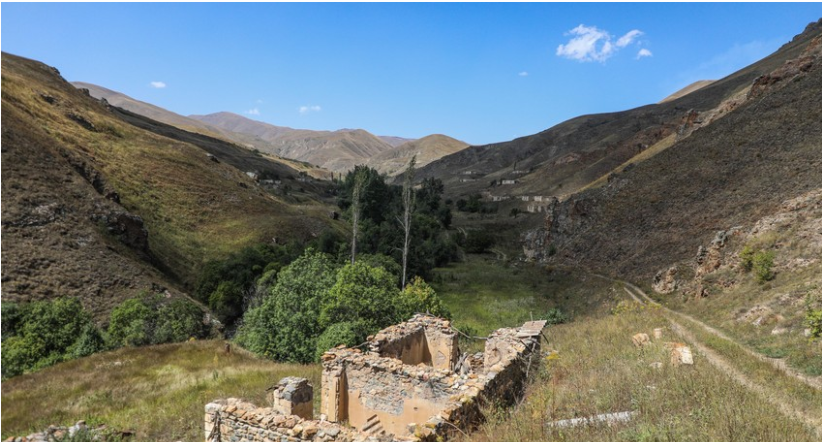Azerbaijan marks 29th anniversary of Bashlibel massacre

By Vafa Ismayilova
Today marks the 29th anniversary of a massacre committed by Armenians during the occupation of Kalbajar region's Bashlibel village in 1993.
Following the Armenian occupation of Kalbajar in early April 1993, 73 residents of Bashlibel village, with a population of around 2,000, were unable to leave their homes in time and sought refuge in the mountain caves to protect themselves from the enemy.
They managed to live in hiding for only 18 days. On April 18, Armenians launched an armed attack on the mountains, where they had taken refuge. As a result, 14 residents were taken hostage and 18 were killed. The remaining 30 people continued their siege by changing their shelters to other mountains in the village. After 113 days, on July 17, they left the shelter and managed to escape the siege of the Armenian army through secret mountain roads, moving only at night.
To recap, the U.S. State Department Bureau of Democracy, Human Rights, and Labor annual report on the global human rights situation in 2021 also cover the details about the Bashlibel tragedy.
After liberating its lands from occupation during the 2020 Patriotic War, Azerbaijan inspected Bashlibel village by a drone. The inspection revealed that all the houses, buildings and infrastructure that existed in the village before the occupation were completely destroyed.
The Prosecutor General's Office investigation evidenced that the Armenian armed forces were particularly cruel to the civilian population in Bashlibel village when they occupied the Kalbajar region with military aggression in early April 1993, as they did in other regions of Azerbaijan.
Under the court decision on corpse exhumation, on April 24, 2021, investigators from the Prosecutor General's Office's Investigation Department conducted an investigation in Bashlibel. As a result, the remains of 12 skeletons were discovered buried at a depth of 50 cm. These remains belong to 12 unarmed Azerbaijanis (a 12-year-old child, a 16-year-old teenager, including six women and six men) who were deliberately killed by the Armenian armed forces on April 18, 1993.
Bashlibel is part of a series of systematic genocide acts that Armenia committed against innocent Azerbaijanis during the first Karabakh war in 1988-94. Kalbajar region also saw the Aghdaban massacre, which occurred a year before Armenian military forces occupied Azerbaijan's Kalbajar region. It is one of the bloodiest chapters in Armenia's anti-Azerbaijan aggression.
During the massacre, the Armenian invaders committed horrifying atrocities, violating both military and international human rights principles by brutally murdering civilians and destroying all historical monuments in the village.
As a result of the Aghdaban tragedy, which resulted in the burning of the entire village, hundreds of civilians were tortured and forced to flee their homes.
Prior to the Khojaly genocide, Armenians committed the worst tragedy in Khojavand region. The Garadaghli genocide was a stain on humanity, and heinous atrocities were committed in Akhullu, Tugh, Salaketin, and Edilli villages at the end of the 20th century. The tragic days in Khojavand villages started in 1988 when the Armenian separatist movement in Karabakh began.
Garadaghli, Akhullu, Tugh, Salaketin, and Edilli fought valiantly against the Armenian invaders for several years. During those years, hundreds of villagers were killed in unequal battles with the Armenian armed forces.
The Khojaly genocide is seen as the pinnacle of the systematic crimes and atrocities committed by Armenia against Azerbaijanis.
Some 613 Azerbaijanis, including 63 children, 106 women and 70 elders were brutally murdered on the ground of national identity in Khojaly in 1992.
A series of previous horrible acts had preceded this one. In Gazakh region's Baghanis-Ayrim village, Armenians set fire to roughly 20 buildings, killing eight Azerbaijanis. A family of five was burned alive, including a 39-day-old infant.
Armenian army killed 12 and injured 15 Azerbaijanis in Garadaghli and Meshali villages of Khojavand and Asgaran regions between June and December 1991.
In August and September of that year, Armenian military detachments bombed buses on the Shusha-Jamilli, Aghdam-Khojavand, and Aghdam-Garadaghli routes, killing 17 Azerbaijanis and injuring over 90 others.
In October and November 1991, Armenians burned, destroyed, and plundered over 30 settlements in the mountainous area of Karabakh, including Tugh, Imarat-Garvand, Sirkhavand, Meshali, Jamilli, Umudlu, Garadaghli, Karkijahan, and other significant villages.
The prosecution of Armenia for the crimes perpetrated against Azerbaijan, as well as the indictment of the aggressor in the international arena, would be a perfect scenario for exposing its true nature and sham diplomacy by ripping down the "oppressed" masks that Armenians have worn for many years.
Armenia has violated the provisions of the Hague Convention for the Protection of Cultural Property in the Event of Armed Conflict (1954) and the Paris Convention on the Illicit Trafficking of Cultural Property (1972) and plundered Azerbaijan’s cultural property in all its former occupied territories.
Many of the Armenia-committed massacres on Azerbaijan's formerly occupied territories meet entirely the requirements of the Genocide Convention, which was approved by the United Nations General Assembly on December 9, 1948. Therefore, these tragedies must be classified as acts of genocide under international law, and the slaughter perpetrated against the civilian population of Aghdaban should be recognized as a genocide crime by the international community.
---
Here we are to serve you with news right now. It does not cost much, but worth your attention.
Choose to support open, independent, quality journalism and subscribe on a monthly basis.
By subscribing to our online newspaper, you can have full digital access to all news, analysis, and much more.
You can also follow AzerNEWS on Twitter @AzerNewsAz or Facebook @AzerNewsNewspaper
Thank you!
